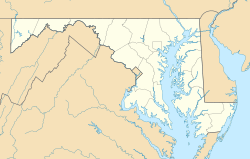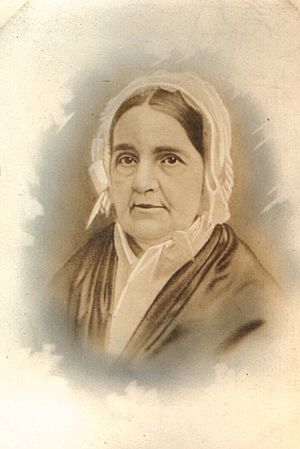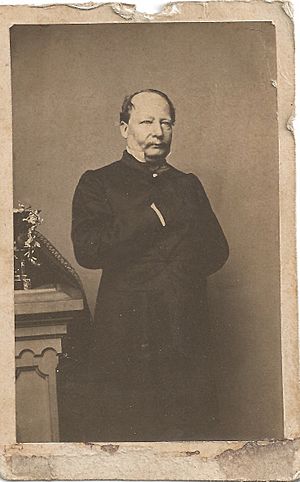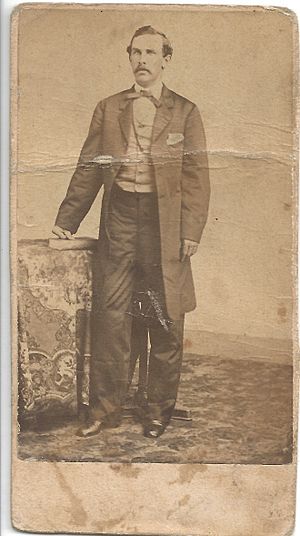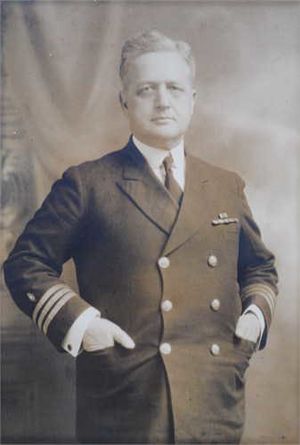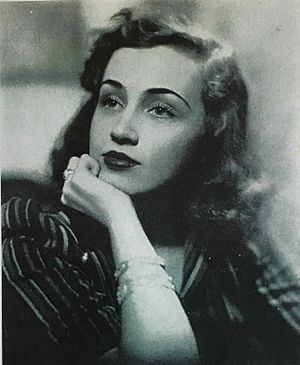Richland Farm (Clarksville, Maryland) facts for kids
Quick facts for kids |
|
|
Richland Farm
|
|
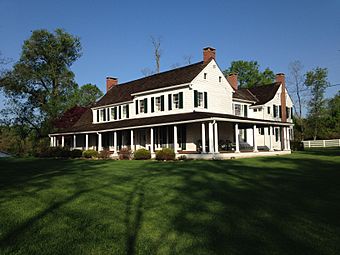
Richland Farm, Main House, May 2014
|
|
| Location | 4730 Sheppard Ln., Clarksville, Maryland |
|---|---|
| Area | 132.75 acres (53.72 ha) |
| Built | 1719 |
| Architect | Turnbull, Bayard (1919-20 changes) |
| Architectural style | Colonial, Colonial Revival |
| NRHP reference No. | 08000217 |
| Added to NRHP | March 26, 2008 |
Richland Farm is a historic house and farm in Clarksville, Maryland. It is located in Howard County, Maryland, in the United States. The main house is made of logs and wood. The oldest part of the house is thought to be from 1719.
The house has three main parts. A large addition was built at the back in 1920. It also has a porch that wraps around the house. This porch has 22 columns in the Doric order style. Other buildings on the farm include a house for the overseer, a gardener's cottage, and a wagon shed. There is also a tractor shed, a smokehouse, a bank barn, and a stone spring house.
Contents
The Farm's Early History
Richland Farm was once part of a large piece of land called "Altogether." This land was first measured on May 10, 1719. It was done by Thomas Worthington and his brother-in-law, Henry Ridgely. A small part of Richland was also from "Worthington's Range."
Thomas Worthington gave 300 acres of "Altogether" to his daughter, Ariana Worthington Watkins. He also gave her 63 acres of "Worthington's Range." Ariana was married to Nicholas Watkins, Jr. In his will, written in 1752, Thomas Worthington said that Ariana's land was already part of a farm.
Ariana divided her land among her three sons. Their names were John, Nicholas, and Gassaway. Richland Farm became part of Gassaway Watkins's share. Gassaway Watkins moved back to Richland after fighting in the American Revolutionary War.
How Richland's Borders Were Set
The current size of Richland Farm was decided in 1801. Its northeast border is next to Doughoregan Manor. Doughoregan Manor was a huge property of 7,000 acres. It later grew to 10,000 acres.
Doughoregan Manor was the summer home of Charles Carroll of Carrollton. He was the last person to sign the United States Declaration of Independence still alive. He was also the only Catholic signer. Like Richland, Doughoregan Manor is still owned by the same family today.
The Watkins Family at Richland
Gassaway Watkins was born in 1752. He was one of the first members of The Society of the Cincinnati in Maryland. This group was started in 1783. He later became the vice president and then president of the Maryland Society. He was president until he died in 1840. He was the last original member of the Maryland Society to pass away.
General George Washington called the Maryland soldiers the "Old Line." This was because they served well and for a long time. Colonel Watkins fought under General William Smallwood. He was at the Battle of Long Island and the Battle of Cowpens.
Gassaway Watkins was married three times. He had several children with his second wife, Ruth Dorsey. After Ruth died, he married Elenora Bowie Clagett in 1803. They had many more children together.
Famous Family Members
One of Gassaway Watkins's daughters, Margaret Gassaway Watkins, married Albert Gallatin Warfield. Their son, Edwin Warfield, was a grandson of Gassaway Watkins. Edwin Warfield served as the 45th governor of Maryland from 1904 to 1908. He lived at Oakdale Manor in Howard County. This house is still standing and is a historic place.
Gassaway Watkins bought more land nearby during his life. This included Hayland Farm and Walnut Grove (Clarksville, Maryland). He built a large house at Walnut Grove that is still there. Gassaway Watkins, Elenora Bowie Clagett Watkins, and other family members are buried at Walnut Grove.
Dr. William Washington Watkins's Time
Dr. William Washington Watkins was a son of Gassaway Watkins. He and his wife, Laura Louise Watkins, eventually owned Richland Farm. They were married in Baltimore in 1837. In 1846, they added a new part to the main house at Richland. This addition included a living room and a bedroom.
Dr. Watkins was offered a spot at United States Military Academy at West Point. However, he chose to become a doctor instead. He studied at the University of Maryland. He also got his medical degree from the Medical College of Philadelphia.
Besides being a doctor, Dr. Watkins was a politician. He was elected to the Maryland legislature. In 1838, he suggested creating the "Howard District" from Anne Arundel County, Maryland. This district became Howard County, Maryland in 1851. He was then elected as the first state senator from Howard County.
Dr. Watkins also served as a judge. He was a director for the Baltimore and Ohio Railroad Company. He was also elected as the Clerk of the Howard County Circuit Court. His son, Louis J. Watkins, later held this same job.
Laura Louise Watkins died in 1850. Dr. Watkins then married Margaret Eleanor Harwood. They had two children together. Dr. Watkins retired to Richland in 1873. He died there in 1880. People remembered him for his kindness and how welcoming his home was.
The Story of Oliver Cromwell Gilbert
Dr. Watkins was the last owner of enslaved people at Richland. The story of Oliver Cromwell Gilbert is important to Richland's history. Oliver was an enslaved person who worked at Walnut Grove. His grandmother, Rachel, was in charge of Richland. Many of Gassaway Watkins's enslaved people lived at Richland.
When Gassaway Watkins died, Oliver was first with Margaret Watkins Warfield. Then he was with Dr. Watkins. In August 1848, Oliver, who was about 16, went to a church meeting. He managed to escape with fourteen other enslaved men. Dr. Watkins put out an advertisement asking for their return.
After his escape, Oliver changed his name to Oliver Cromwell Gilbert. His life story has been written about in history magazines and books.
Later Owners of Richland Farm
Joshua Worthington Dorsey later owned Richland Farm. His wife, Eleanor Watkins Dorsey, was a daughter of Dr. Watkins. Joshua Dorsey was a soldier in the Civil War. He owned many farms and a large farm supply business in Ellicott City, Maryland. He sold coal and fertilizers. He also rented out horses and vehicles.
Joshua Dorsey made many improvements to Richland. He added the bank barn and a corn crib. He also added a cistern in the attic of the main house. This cistern collected rainwater for use inside the house. Joshua and Eleanor Dorsey had many children. After Eleanor died in 1893, Joshua married Katherine Cooke Worthington.
Renovations and Gatherings
When Joshua Worthington Dorsey died in 1918, two of his children bought Richland. They were Achsah Maria Dorsey Serpell and Joshua Worthington Dorsey, Jr. They hired a famous architect, Bayard Turnbull. He renovated and expanded the main house between 1919 and 1920.
After the renovations, Richland became a place for many family gatherings. Achsah Dorsey Serpell's brother, Rear Admiral Benjamin Henry Dorsey, and his wife hosted parties there. These parties were for people from the "navy crowd" in Washington, D.C. A newspaper article from 1939 described a large party at Richland. Hundreds of guests, including high-ranking Navy officers, attended. There was tea on the lawn and dancing inside.
Passing Through Generations
In 1953, Achsah Dorsey Serpell gave Richland to her niece, Achsah Bowie Dorsey Smith. Achsah Bowie Dorsey was a society reporter for newspapers like the Washington Post. She wrote a daily column called "Ask Achsah."
Richland Farm was then passed to Achsah Dorsey Smith's niece in 2005. This means that Richland Farm has stayed in the same family for over 300 years. Eight generations of the family have lived there.
Richland Farm was added to the National Register of Historic Places in 2008.
Images for kids
- Richland Farm, Howard County, at Maryland Historical Trust


